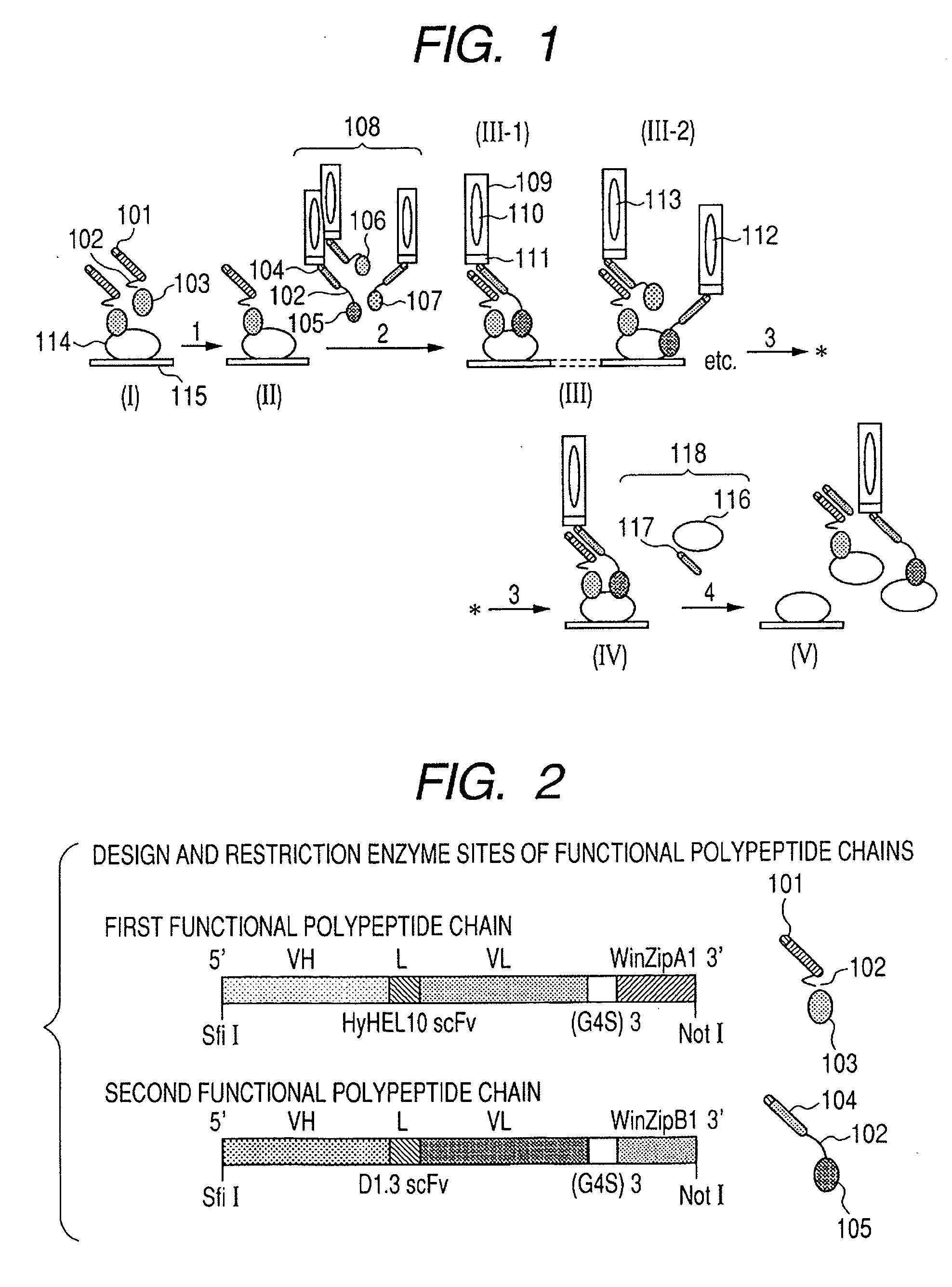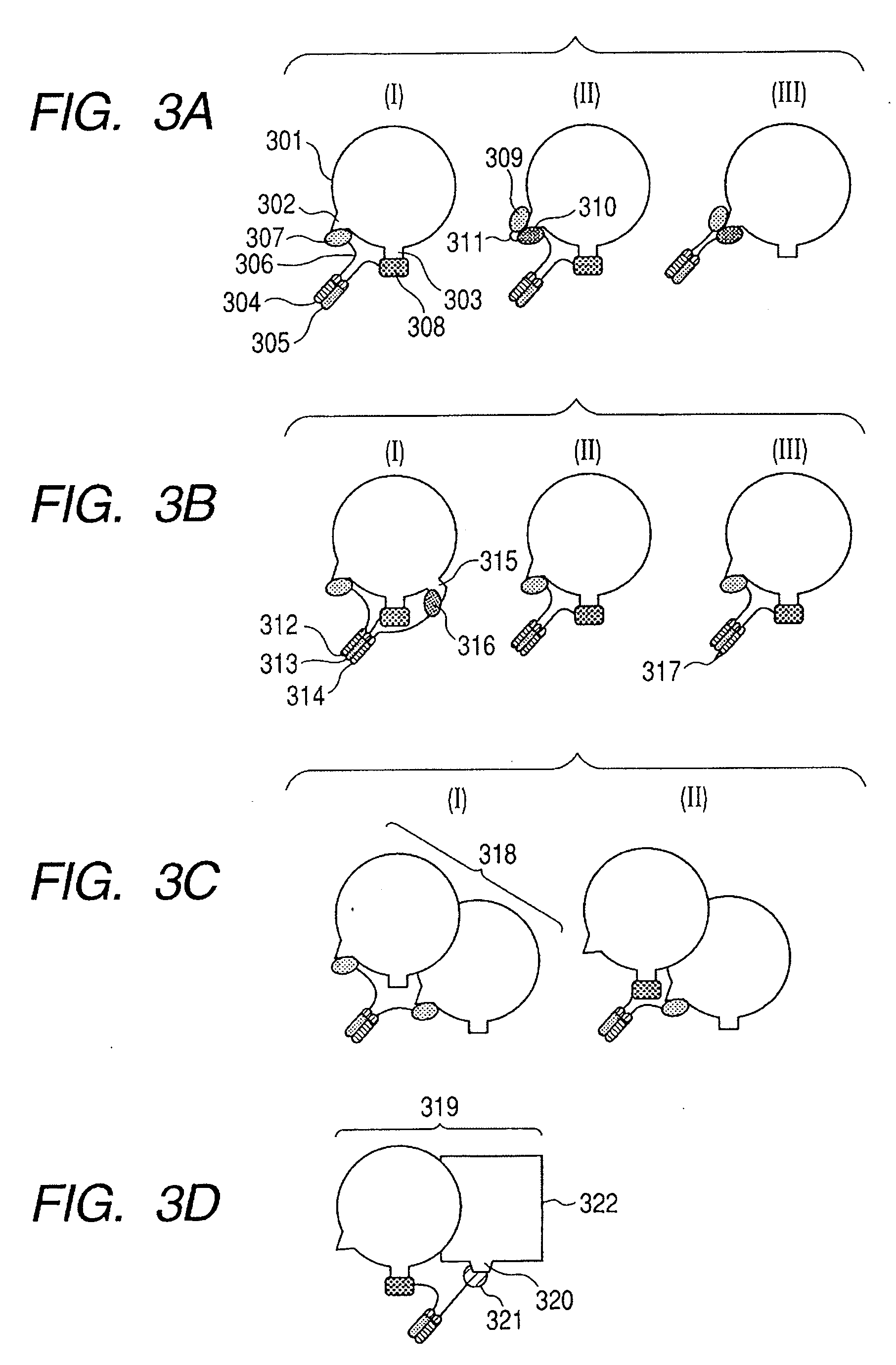Method for producing target substance capturing protein and method for selecting component materials thereof
a target substance and protein technology, applied in the field of producing a target substance capturing protein, can solve the problems of difficult to obtain high-affinity molecule from a certain antibody, target substances do not permit, and the production of monoclonal antibodies requires large-scale equipment and high cost, so as to achieve convenient and practical selection
- Summary
- Abstract
- Description
- Claims
- Application Information
AI Technical Summary
Benefits of technology
Problems solved by technology
Method used
Image
Examples
example 1
[0205] At first, functional polypeptide chains are designed to have structures described below. The functional polypeptide chains have target substance-binding domains, association sites between the functional polypeptide chains, and linker sites connecting the binding domains and association sites. Anti-HEL antibody fragments HyHEL10 scFv (Biophysical Journal Vol. 83, 2946-2968 (2002)) and D1.3 scFv (McCafferty et al., Nature 348, 552-554 (1990)) are used as the target substance-binding domains. A WinZipA1 / WinZipB1 combination (Andreas Pluckthun et al., J. Mol. Biol. 295, 627-639 (2000)) having a hetero-associating property is used in the association sites between the functional polypeptide chains. (Gly4Ser)3 peptides are used in the linker sites. Similarly, the (Gly4Ser)3 peptide is connected between VH and VL of the scFv of the target substance-binding domain (FIG. 2). In Examples described below, a peptide HyHEL10 scFv-(G4S)3-WinZipA1 having HyHEL-10 scFv and WinZipA1 is used as...
example 2
[0212] RE: second functional polypeptide D1.3 scFv-(G4S)3-WinZipB1
[0213] At first, the pCANTAB 5 E phagemid vector included in RPAS Expression Module, a kit for preparing expression constructs, of Amersham Recombinant Phage Antibody System (RPAS) is prepared by cleavage with SfiI / NotI. The D1.3 scFv-(G4S)3-WinZipB1 construct constructed in Example 1 is cleaved with SfiI / NotI. Subsequently, the band of interest is excised by electrophoresis and ligated between the SfiI / NotI sites of the pCANTAB 5 E phagemid vector to construct pCANTAB 5 E-(D1.3 scFv-(G4S)3-WinZipB1). The PRAS system is a phage display system that can express scFv fragments of a variety of mouse (κ) antibodies as fusion proteins with phage gene 3 proteins (g3p) on the M13 phage tips and select the recombinant scFv fragments having high affinity to the antigen.
[0214] RE: population of additional scFv-(G4S)3-WinZipB1
[0215] PCR is performed using the D1.3 scFv-(G4S)3-WinZipB1 construct as a template and Primers 7 and ...
example 3
[0217] The respective constructs prepared in Example 1, which encode the first functional polypeptide chain (HyHEL10 scFv-(G4S)3-WinZipA1) and the second functional polypeptide chain (D1.3 scFv-(G4S)3-WinZipB1) are separately transformed into E. coil BL21 (DE) strains (Novagen; Cat. No. 69450-4). The strains are cultured at 30° C. for 16 hours in ampicillin (100 μg / ml)-selective LB medium. IPTG is added thereto at the final concentration of 1 mM, followed by additional 16-hour culture to induce protein expression. The bacterial cells collected by centrifugation are subjected to osmotic pressure treatment (the bacterial cells are mixed with 0.5 M sucrose solution and supplemented with a 5-fold volume of pure water) and disrupted by French press to obtain as soluble fractions, the proteins of interest present in the E. coli periplasms. Next, the functional polypeptide chains are purified with HEL columns (HEL is adsorbed and immobilized onto CNBr-activated Sepharose 4B (Code No. 17-04...
PUM
| Property | Measurement | Unit |
|---|---|---|
| Strength | aaaaa | aaaaa |
| Bond strength | aaaaa | aaaaa |
Abstract
Description
Claims
Application Information
 Login to View More
Login to View More - R&D
- Intellectual Property
- Life Sciences
- Materials
- Tech Scout
- Unparalleled Data Quality
- Higher Quality Content
- 60% Fewer Hallucinations
Browse by: Latest US Patents, China's latest patents, Technical Efficacy Thesaurus, Application Domain, Technology Topic, Popular Technical Reports.
© 2025 PatSnap. All rights reserved.Legal|Privacy policy|Modern Slavery Act Transparency Statement|Sitemap|About US| Contact US: help@patsnap.com



